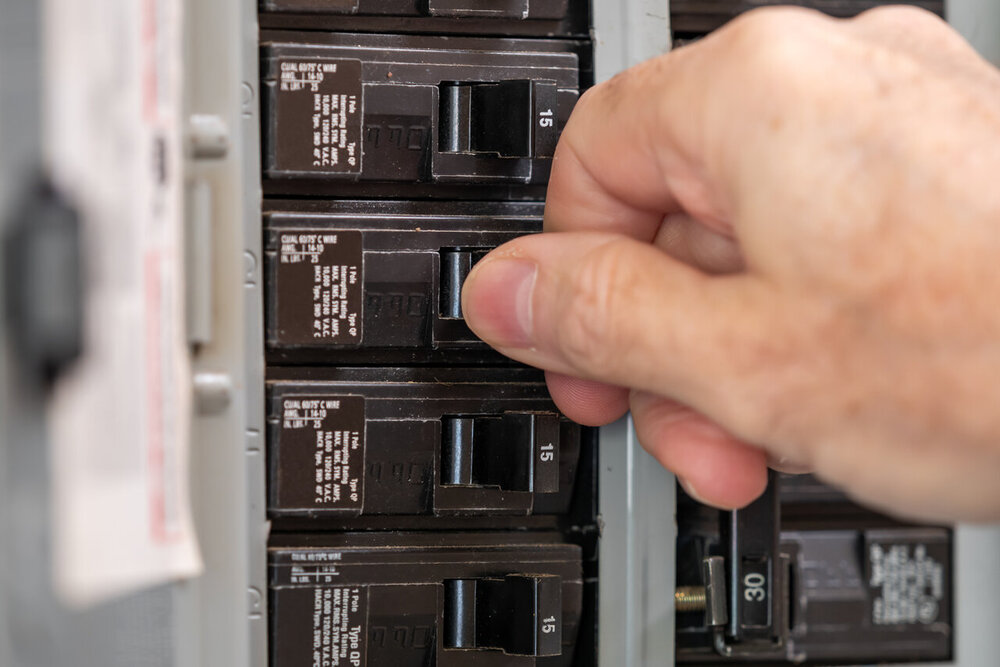The Different Types Of Circuit Breakers
(And Why GFCI And AFCI Breakers Are Essential)
Circuit breakers are critical components in your home’s electrical system, responsible for protecting you and your property from electrical hazards. However, not all circuit breakers are the same. Knowing the different types of circuit breakers available and understanding why specialized types like GFCI (Ground Fault Circuit Interrupters) and AFCI (Arc Fault Circuit Interrupters) are essential can help you make informed decisions about your home’s safety.
What Is a Circuit Breaker And How Does It Work?
At its core, a circuit breaker is a device that interrupts the flow of electricity when it detects an issue such as an overload or a short circuit. Without circuit breakers, an overloaded circuit could overheat, potentially causing an electrical fire or damaging your appliances.
When the electrical current becomes too strong, the breaker trips, cutting off the power to prevent further damage. After addressing the issue, you can reset the breaker to restore the power, making circuit breakers a vital safety component in both homes and businesses.
Types Of Circuit Breakers For Your Home
There are several types of circuit breakers, each designed to protect against different electrical hazards. Here’s an overview of the most common ones:
Standard Circuit Breakers are the most common breakers found in residential electrical panels. They protect your home by stopping the flow of electricity when they detect overloads or short circuits. Standard breakers are typically used in areas like living rooms, kitchens, and bedrooms. While they offer basic protection, they don’t guard against all types of electrical risks.
GFCI Breakers are designed to prevent electrical shocks by detecting ground faults, which occur when electricity escapes the wiring and flows into an unintended path—such as through water or a human body. These breakers are mandatory in areas where water is present, like kitchens, bathrooms, and outdoor outlets. By shutting off the power as soon as they detect an imbalance in the electrical current, GFCI breakers can prevent serious injury or electrocution.
AFCI Breakers protect against arc faults, which are sparks caused by damaged or frayed wiring. Arc faults can easily ignite surrounding materials, making them a major fire hazard. AFCI breakers detect these dangerous sparks and shut off the circuit before a fire can start. In many areas, building codes require AFCI breakers in places like bedrooms and living spaces to protect against these hidden dangers.
Why GFCI And AFCI Breakers Are Essential For Safety
While standard breakers provide basic protection, GFCI and AFCI breakers offer enhanced safety features that go beyond simply preventing overloads.
Preventing Electrical Shocks: GFCI breakers monitor the flow of electricity and detect even the smallest imbalances, which can indicate a ground fault. For example, if you’re using a hairdryer in the bathroom and it comes into contact with water, a GFCI breaker will immediately cut off power to prevent electrocution. According to the Electrical Safety Foundation International (ESFI), GFCIs have cut household electrocutions in half since their introduction, making them an essential safety upgrade for any home.
Preventing Fires: Arc faults occur when electrical currents jump across gaps in frayed or damaged wires, producing sparks. These sparks can quickly ignite surrounding materials, leading to fires. AFCI breakers detect these arcs and disconnect the power before a fire can start. This type of breaker is particularly important in older homes, where wiring may be more prone to damage and deterioration. The National Fire Protection Association (NFPA) reports that AFCI breakers have significantly reduced the number of electrical fires in homes where they’ve been installed.
Upgrading To GFCI And AFCI
If your home was built before GFCI and AFCI breakers were required by building codes, it might be time to upgrade. In newer homes, these breakers are standard in certain rooms, but older homes may still rely on basic breakers that don’t offer the same level of protection.
GFCI Requirements: GFCI breakers are required by the National Electrical Code (NEC) in areas where water is present, such as kitchens, bathrooms, laundry rooms, garages, and outdoor outlets.
AFCI Requirements: AFCI breakers are required in most rooms where people sleep or spend extended time, including bedrooms, living rooms, and dining areas. They are designed to detect electrical arcs, which can easily go unnoticed until they cause a fire.
Although upgrading your electrical panel to include these safety features involves some initial cost, the protection they provide is well worth it. For older homes especially, replacing standard breakers with GFCI and AFCI models can significantly reduce the risk of electrical shock or fire.
Common Myths About Circuit Breakers
There are a few misconceptions about circuit breakers, especially when it comes to GFCI and AFCI technology. Let’s clear up some of the most common myths:
Myth #1: “If a breaker trips frequently, it’s not a big deal.”
In reality, frequent breaker trips are often a sign of underlying electrical problems. If your breaker is tripping regularly, you may be overloading the circuit or dealing with faulty wiring—both of which can be dangerous if left unaddressed.
Myth #2: “Standard breakers are enough for all parts of the home.”
This is a common misunderstanding. Standard breakers protect against overloads and short circuits, but they won’t protect you from ground faults or arc faults, which are more common in areas like bathrooms and bedrooms. GFCI and AFCI breakers provide an additional layer of protection that standard breakers simply can’t.
Myth #3: “AFCI breakers are unnecessary in older homes.”
Even if your home predates current building codes, AFCI breakers are still important. In fact, older homes are often more at risk of arc faults due to aging wiring. Installing AFCI breakers can prevent fires caused by electrical arcing, which might otherwise go undetected.
Whether you’re building a new home, remodeling your Seattle or Eastside business, or simply looking to enhance your home’s safety, understanding the different types of circuit breakers is key. While standard circuit breakers offer basic protection, GFCI and AFCI breakers go above and beyond to safeguard your home from electrical shocks and fires. If you’re unsure whether your home is adequately protected, consulting with a licensed electrician is the best way to ensure your electrical system meets today’s safety standards.
Protecting your home starts with understanding your options—and GFCI and AFCI breakers are two of the best safety measures you can invest in.









